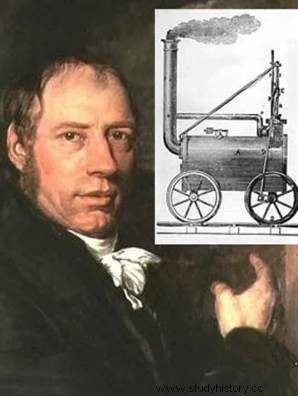 We can consider Richard Trevithick as the inventor of the train when itsfirst steam locomotive appeared in Cornwall, in the south of England, in 1804. From 1840, the railroad knew a dazzling development in the countries which had coal, or which could easily import it, like Europe and the United States -United. This invention will accompany the conquest of territories (notably in the American West or in Siberia) and above all induce economic growth on an exceptional scale in industrialized countries. The railway and the trains that run along it will become familiar to the urban and rural landscape.
We can consider Richard Trevithick as the inventor of the train when itsfirst steam locomotive appeared in Cornwall, in the south of England, in 1804. From 1840, the railroad knew a dazzling development in the countries which had coal, or which could easily import it, like Europe and the United States -United. This invention will accompany the conquest of territories (notably in the American West or in Siberia) and above all induce economic growth on an exceptional scale in industrialized countries. The railway and the trains that run along it will become familiar to the urban and rural landscape.
Richard Trevithick and the first steam locomotive
At the origin of the railway, there is an infrastructure designed to limit energy loss by guiding vehicles using ruts dug into the ground or wooden rails. It was possible, thanks to the muscular strength of men or animals, to tow relatively heavy loads:the carts moving on "wooden paths" were thus used from the Middle Ages for mining, in particular in England and in the country. of Wales. But with the increase in the demand for raw materials from the end of the 18th century, the increase in the volumes transported; required the infrastructure and traction to be upgraded.
 The rails, first reinforced with metal plates, were gradually replaced by cast iron bars, iron and then steel. The small railway line linking the mines of Montcenis to Le Creusot was, around 1780, one of the first in France to be provided with it. At the dawn of the 19th century, the railway links ultimately formed only short sections qu:sold the raw materials from the centers of extraction or transformation to larger communication routes, such as the canals. But for the railways to be able to develop, an efficient mode of traction was needed.
The rails, first reinforced with metal plates, were gradually replaced by cast iron bars, iron and then steel. The small railway line linking the mines of Montcenis to Le Creusot was, around 1780, one of the first in France to be provided with it. At the dawn of the 19th century, the railway links ultimately formed only short sections qu:sold the raw materials from the centers of extraction or transformation to larger communication routes, such as the canals. But for the railways to be able to develop, an efficient mode of traction was needed.
On February 21, 1804, the Englishman Richard Trevithick started a first operational steam locomotive, towing a few wagons inside which took place, on February 21, the very first travelers on the railroad. Eight years later, in 1812, engineer John Blenkinsop built a locomotive capable of running at 8 km/h while towing 94 t. At the end of the 1820s, Marc Seguin, in the Annonay region, and George Stephenson, in England, contributed, each on their own, to the development of the tubular boiler which finally provided enough pressure for a limited space. . George Stephenson wrote his name in history in 1829 when his Rocket won the Rainhill Speed Contest on the line between Liverpool and Manchester. With his only son, Robert, George Stephenson was to lay the foundations of “railway science” and the modern locomotive.
The rapid transport of large quantities of materials between different economic areas will play a fundamental role in the industrial revolution in England. Railways are used by manufacturers who transport ores, steel products or textiles on tracks created within the walls of their factories.
The development of the railway in France
In France, after the first lines built around Saint-Étienne (from 1827) and in the Gard, the "school" line from Paris to Saint-Germain-en -Laye (1837) was intended as a showcase, an enlightening demonstration of the power of the rail carried out by the bankers Émile and Isaac Pereire, and the engineer Eugène Flachat. It was also a manifesto of the Saint-Simonian current, promoter of the free movement of goods and people. But in the face of the “Railwaymania” of the 1830s, several voices were raised to express their anguish or their skepticism:weren’t these smoking locomotives that were carrying boiling water and burning coal at high speed dangerous? And what would be the effects of speed on health?
 Several accidents have indeed marked the history of the front lines, and the Meudon disaster, which lives in May 1842 the death of 55 people, including Rear Admiral Dumont d'Urville, struck people's minds for a long time. Several years of debate would, however, lead to the birth of a network of lines radiating from Paris, the "Legrand star", named after the general director of Ponts et Chaussées. The lines, built with the greatest care, were equipped with sometimes spectacular works of art allowing them to cross the torments of the relief.
Several accidents have indeed marked the history of the front lines, and the Meudon disaster, which lives in May 1842 the death of 55 people, including Rear Admiral Dumont d'Urville, struck people's minds for a long time. Several years of debate would, however, lead to the birth of a network of lines radiating from Paris, the "Legrand star", named after the general director of Ponts et Chaussées. The lines, built with the greatest care, were equipped with sometimes spectacular works of art allowing them to cross the torments of the relief.
Relying on proven know-how in mechanical engineering, a remarkable French industry has produced and exported high-quality locomotives, renowned for their reliability. The Derosne et Cail house thus built several Cramptons, these "rail greyhounds" capable of towing light passenger trains at nearly 100 km/h under the Second Empire. Other advances, such as overheating, double expansion or continuous braking, have helped to optimize operating profitability while increasing safety. The latter has also been the subject of all attention since the 1870s, with the generalization of mechanical signals, then electrical, guaranteeing the safety of train operation.
During the Belle Époque, the Freycinet plan, then nearing completion, allowed all the sub-prefectures to be connected to the network, participating in the unification of the market national. The railway was then part of the landscape of the Third Republic, in the same way as the public school or the post office. And on a continental scale, prestigious connections put London and Paris at the gates of the Riviera or the Bosphorus, while across the Atlantic, the first transcontinental connection, completed in 1869, reminded us of the importance of rail in the conquest of the West.
The train, an ever popular mode of transport
Competed with in the 20th century by aviation and then by the development of the automobile, the railway still remains a privileged mode of transport both for local connections (trains suburban or regional), medium distance or international. And if the choice of high speed, which contributed to the revival of rail from the 1980s, is debated today, it is clear that the technical system imagined almost two centuries ago has largely proven itself.
To go further
- History of the railways in France, by Francois Caron. Fayard, 1997.
- History of train travel, by Wolfgang Schivelbusch. The Walker, 1990.
